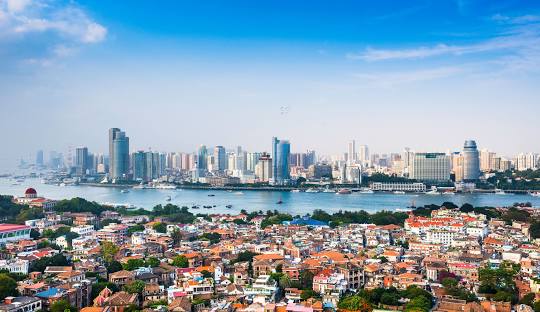Travel Tips
Xiamen, China
 Xiamen
is a coastal city in Fujian Province in China.
It has been an important port for centuries and became one
of China's earliest Special Economic Zones in 1980. The name
Xiamen means "door to the house", referring to the city's
centuries-old role as a gateway to China.
Xiamen
is a coastal city in Fujian Province in China.
It has been an important port for centuries and became one
of China's earliest Special Economic Zones in 1980. The name
Xiamen means "door to the house", referring to the city's
centuries-old role as a gateway to China.
Xiamen is a very vibrant, affluent and modern place, though
by Chinese standards it is a small city — only 5.1 million
counting suburbs (2020). It has many non-Chinese residents
and a range of restaurants, bars and stores that cater to
them. It also has several universities and some areas
popular for tourism.
The most important tourist area is Gulangyu, a small island
close to downtown which contains some beautiful colonial
buildings and is car free. It is now listed as a UNESCO
World Heritage Site.
1. Its Cultural Attractions
1. The Cannon Extremes
Plane
Xiamen is a sophisticated place with endless
cultural attractions. Some standouts include
the jade exhibits at the Xiamen Shinegood
Gallery and the street painters on Gulang Yu
Island.
2. Historic Attractions and Stunning
Parks
From the Hulishan Fortress overlooking the
strategic harbor, to the hillside Nanputuo
Temple complex, Xiamen is rich in history.
It also boasts green spaces like Bailuzhou
Park, where every evening sees dancers take
to the grass.
3. Sandy Beaches and Exciting Activities
Xiamen has a long, sandy accessible beach
(and great sunbathing weather). You can
lounge around or try kite surfing - a local
obsession.
4. Lively Nightclubs and Music Events
Xiamen is a party town, with pulsating
discos like Dushang, a cluster of clubs
around Haiwan Park and a student scene
around Zhengcuoan.
5. Gulang Yu
Xiamen's sister island Gulang Yu can be
reached by boat and is a wonderful place to
explore, with its painters, bohemian cafes
and old European architecture.
Located in a classic defensive position atop
a hill, this military fort designed to
protect the waterfront of Xiamen was built
in 1894. China has undergone significant
changes throughout its history, and this
time period is one that's not always
discussed as frequently, which is what makes
visiting the Huli Mountain Fort such a
unique experience. The fort holds some of
the largest cannons in the world, but its
museum also presents the smallest.
2. History Enshrined In Buildings
Also known as the Nanputuo Temple, this is a
famous Buddhist temple dating from the Tang
Dynasty and one of the most well known in
Xiamen. Nestled among the mountains that
tower around the port city, this temple is
not just artistically beautiful, but gives
all visitors the opportunity to savor its
serenity. The temple underwent some
restoration in the 1980s, which is great
news because now you can really see it in
its full splendor, just as the Tang Dynasty
Buddhists would have wanted.
3. Artistic Graffiti
While street art may be frowned upon in some
places, it's celebrated in the Furong Tunnel
in Xiamen. The tunnel is around 1,000 feet
long and was originally built to connect the
Xiamen University campus with the dorms, but
has now become a sort of urban museum for
budding artists of all ages. Because there
aren't many places where graffiti is so
welcome, it's a unique opportunity to admire
these works of art rather than scorn them.
4. Just Say Om
In many Chinese cities it can be hard to get
away from the hustle and bustle to just
enjoy the day and take a breather. The
Xiamen Botanical Garden is the perfect place
to do that, however, as it boasts hundreds
of native flora and fauna specimens and more
than 6,000 tropical and sub-tropical species
covering nearly five square kilometers. In
these quiet, magical gardens, you'll
completely forget you're near a big city and
not in the middle of a fairy tale.
5. The Museum Of The Obscure
China is a country where high end luxury
lives alongside the quirky and sometimes
downright odd. That's no bad thing, though,
because this quirkiness is what brings us
some of the most ingenious products and, in
this case, the most interesting museums.
Huaijiu Gulangyu Museum is located on
Gulangyu island and it may be small, but
you'll find an incredibly fascinating
history and get a glimpse of what life was
like in China's past. The two main focuses
of this museum are pianos and old furniture,
two subjects that don't sound like they
would make for a particularly intriguing
museum. However, the rich history of these
70-odd pianos is anything but boring. You'll
also find over 100 pieces of old furniture
preserved from different periods of Chinese
history.
Gaoqi International Airport has links to
other Chinese cities (and Seoul). Bus lines
2 and 3 run from the airport to the city
center and charge CNY10 and 15 respectively.
Taxis cost around CNY35.
Train
Superfast bullet-style trains serve Xiamen.
The journey from Shanghai costs CNY330 and
takes about 8 hours.
Car
Take the G25 from Shanghai, then the G72 at
Yong'An, or take the G15 northbound from
Hong Kong.
Bus
Buses run into Xiamen from Beijing,
Shanghai, Hong Kong and Fuzhou and are an
excellent budget alternative to trains and
flights.
